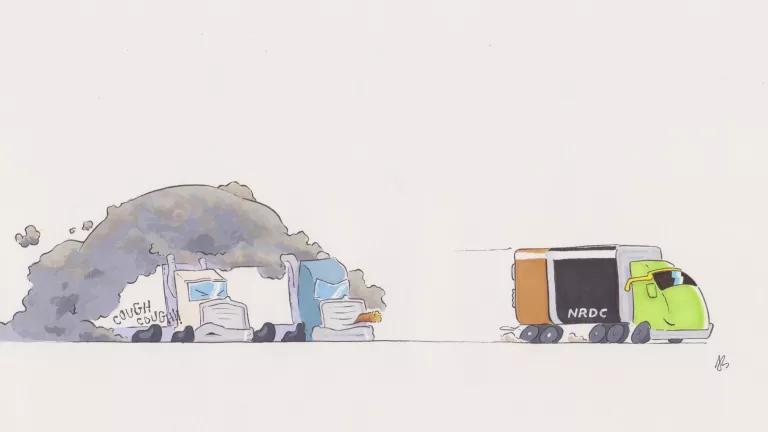California's Clean Truck Rule: First of its Kind and Long Overdue
California is launching a new rule to tackle one of the largest sources of pollution: medium- and heavy-duty trucks.

Artist: Andrew Schubert, Instagram
California officials are gearing up to launch a momentous new rule to tackle one of the largest sources of pollution in the state: medium- and heavy-duty commercial trucks. After years of deliberation and public input, the rule is the first of its kind and long overdue.
Traditional, diesel-burning medium- and heavy-duty trucks—which range from F-250s to 18-wheelers—are big sources of smog-forming pollutants, carcinogenic particulates, and climate forcing greenhouse gases. I’m sure everyone has experienced either holding their breath or coughing in disgust when a truck rolled by spewing black fumes. It goes without saying, but those fumes are horrible for our health and the environment. While California’s electricity sector keeps getting cleaner, pollution from cars and trucks has been heading in the wrong direction.
To add insult to injury, asthma and other severe respiratory diseases air pollution causes are especially harmful to the most vulnerable among us, including children and seniors, as well as communities of color and low-income communities that are often located near commercial trucking hubs. California already has some of the most effective clean car rules—isn’t it time we had the same for trucks?
If the Advanced Clean Truck Rule is adopted by the California Air Resources Board, medium- and heavy-duty truck manufacturers would be required to sell zero-emission trucks as an increasing percentage of their annual California sales from 2024 to 2030. The rule would also require fleet owners with +100 trucks to report information about their operation. The data will inform future policies to ensure fleets purchase and use zero-emission trucks.
With more zero-emission truck sales, the new Advanced Clean Truck Rule will replace those black fumes with… what?
The main zero-emission technologies are battery electric and hydrogen vehicles. But not all technologies are created equally. The best bang for our buck comes from electric trucks because they offer the biggest emission reductions AND the biggest cost savings over the vehicle’s lifetime.
To better understand what makes battery electric trucks one of the best options, let’s peek under the hood of the technology.
Electrification: The Gift That Keeps on Giving
According to an exhaustive review by ICF Consulting, battery electric trucks cut greenhouse gas and criteria pollutant emissions more than any other type of vehicle—and will continue to do so as more of California’s electricity is generated by clean, renewable energy. It’s the gift that keeps on giving.
The chart below from Union of Concerned Scientists illustrates the large emission reductions battery electric buses—a proxy for medium- and heavy-duty vehicles—offer in California compared to diesel buses.

Electric trucks have zero direct tailpipe emissions: i.e. no black fumes. And compared to fossil fuel trucks, they can reduce greenhouse gases and other harmful pollutants by 90% over their entire lifetime. So, if California is serious about reaching its emission goals, a lot more electric trucks are needed on the road.
And they are needed ASAP. To cut greenhouse gas emissions from transportation by 80% by 2050, zero-emission vehicle sales may need to accelerate as soon as 2025 and all new vehicle sales should be zero-emission by 2040. This would leave enough time for California’s fleet to become mostly zero-emitting by 2050.
To add another wrinkle, freight shipping will likely continue to increase in California. The number of miles driven by trucks is expected to grow by 50% from 2010 to 2050. The convenience of two-day delivery is not without cost.
Much of this growth will come from the already heavily polluted regions of Southern California and the San Joaquin Valley.
If more miles are driven by black-fume-belching trucks, emissions overall will increase. In other words, switching to clean technologies must happen as quickly or faster than the growth of truck miles driven to make a dent in emissions.
A Winning Formula for Total Cost of Ownership
Equally important is that electric truck technology is advancing rapidly while costs are falling. Thanks to manufacturing efficiencies from economies of scale and cheaper batteries, electric truck sticker prices are coming down. Batteries—the single most expensive part of an electric truck—are particularly exciting because prices have dropped by roughly 20% per year since 2009 and are likely to continue falling through 2030.
Lithium-ion battery pack price (real 2018 $/kWh)

On top of falling prices, the cost of maintaining an electric truck is cheaper than other technologies thanks to fewer moving parts and regenerative breaking that reduces the wear and tear on brakes. With widespread electrification, mechanics will become more familiar with the technology and maintenance costs will fall further.
Not only do electric trucks cost less to maintain, but they are also considerably more efficient than their diesel or natural gas counterparts. To put this into context, an electric bus running on electricity produced by natural gas can go twice as far as a natural gas bus with the same amount of gas in its tank.
While electric trucks require less energy to perform the same operations, they also “fill up” using cheaper and more stable electricity prices. Although electricity prices are typically less expensive than diesel, utility rate structures play an outsized role in determining electric vehicle fuel costs. Medium- and heavy-duty fleets will need to work closely with their utilities to ensure they are on the most attractive rates.
Short-Haul Today, Tomorrow the World
The tasks electric trucks can perform and the distance they can travel on a single charge are impacted by their battery’s energy density. Although this is constantly improving, and battery sizes are shrinking, they still have some range constraints.
All this means is that electric trucks—outfitted with today’s technology—are well suited for short-haul trips with lots of stops. Obvious places where electrification is a perfect fit today are delivery and drayage trucks, shuttle and transit buses, garbage trucks, terminal tractors, and school buses.
This is where we are today. It is important to note that the technology is constantly improving and over the next ten years batteries will continue to shrink, last longer, and pack a more powerful punch.
Shadowing California’s Advanced Clean Truck Rule
The Advanced Clean Truck Rule is a welcome first step to address harmful emissions from medium- and heavy-duty trucks. The substantial environmental benefits and cost savings battery electric trucks offer make them a compelling option today. This is the first in a series of blogs that will examine the zero-emission truck landscape as California’s rulemaking process continues.



